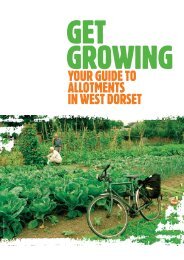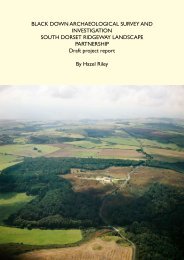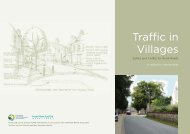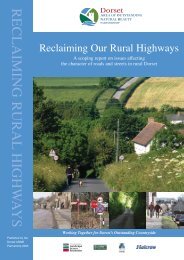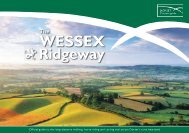Woodland Strategy 11.34 Mb - the Dorset AONB
Woodland Strategy 11.34 Mb - the Dorset AONB
Woodland Strategy 11.34 Mb - the Dorset AONB
Create successful ePaper yourself
Turn your PDF publications into a flip-book with our unique Google optimized e-Paper software.
Section 4<br />
32<br />
There is now an overwhelming body of scientific evidence that indicates that climate change<br />
is a serious and urgent issue. And whilst <strong>the</strong>re are some remaining uncertainties about <strong>the</strong><br />
eventual impacts, <strong>the</strong> evidence is now sufficient to give clear and strong guidance to<br />
policy-makers about <strong>the</strong> pressing need for action.<br />
Climate change is potentially a serious threat to society at every level. With changes in<br />
precipitation patterns, warmer temperatures and more carbon being emitted than<br />
sequestered, trees, woods and forests have an important role to play in reducing this impact.<br />
A landscape scale approach to new planting provides <strong>the</strong> opportunity to adapt for <strong>the</strong> future,<br />
planting tree species that will combat <strong>the</strong> changes in <strong>the</strong> environment, sequester or off-set<br />
carbon, provide a sustainable fuel source for <strong>the</strong> future and reduce habitat fragmentation.<br />
There is significant effort underway throughout <strong>the</strong> South West region to conserve our<br />
biodiversity but major challenges lie ahead if we are to stop fur<strong>the</strong>r losses, re-establish lost<br />
wildlife and enable it to adapt to <strong>the</strong> pressures of climate change. The South West Nature<br />
Map shows <strong>the</strong> best areas to maintain and expand (through restoration and/or re-creation)<br />
terrestrial wildlife habitats at a landscape scale.<br />
With <strong>the</strong> correct planning and investment trees, woods and forests can deliver a multitude<br />
of benefits. The management of <strong>Dorset</strong>’s trees, woods and forests will have to improve in<br />
order to combat <strong>the</strong> threat of climate change and provide increased recreational and access<br />
opportunities. There must be robust mechanisms in place for producing quality wood<br />
products with minimal environmental impact whilst at <strong>the</strong> same time providing opportunities<br />
for recreation and development of a green infrastructure.<br />
Many existing trees, woods and forests are under pressure from developments, particularly<br />
in urban and peri-urban areas. In particular, individual trees in urban areas are likely to face<br />
increasing pressure from developments and in 2008 <strong>Dorset</strong> County Council produced a Tree<br />
Policy to take forward a co-ordinated approach to <strong>the</strong> issues facing urban and highway trees.<br />
Ecotowns, growth points and low cost housing will also have an impact of trees, woods and<br />
forests and <strong>the</strong>se present an opportunity to bring toge<strong>the</strong>r and develop a green<br />
infrastructure around urban areas providing a better living environment.<br />
Overstood hazel coppice © David Rees<br />
Many old orchards have been lost simply because<br />
<strong>the</strong>y have not been valued by <strong>the</strong> authorities that<br />
control development. Local councils have to find<br />
land for housing quotas assigned to <strong>the</strong>m by<br />
central Government. Economically dormant<br />
orchards within and on <strong>the</strong> edges of villages and<br />
towns may present lucrative opportunities for<br />
development for landowners who have found<br />
it difficult to continue to make a living in<br />
horticulture. Small orchards which may be<br />
beautiful features in <strong>the</strong> centre of villages<br />
commonly succumb to infill policies. Today <strong>the</strong>se<br />
remaining trees are <strong>the</strong> last of <strong>the</strong>se regional<br />
varieties and face extinction if <strong>the</strong>y are not<br />
nurtured properly. The value of old orchards was<br />
highlighted in August 2007 by <strong>the</strong>ir designation<br />
by DEFRA as priority habitats in UK Biodiversity<br />
Action Plans. They were added to <strong>the</strong> list because<br />
of <strong>the</strong>ir scarcity, <strong>the</strong> orchard area in England<br />
having declined by 57% since 1950, and because<br />
of <strong>the</strong>ir importance for many kinds of wildlife.<br />
Increasingly central government is passing decision making and financing down to <strong>the</strong> local<br />
level. This means that <strong>Dorset</strong> will have more responsibility for its own affairs and so this<br />
strategy is <strong>the</strong> first step in highlighting what trees, woods and forests can offer in <strong>Dorset</strong>.<br />
The wider Rural Development Programme for England (RDPE) as well as its Environmental<br />
Stewardship and England <strong>Woodland</strong> Grant Scheme (EWGS) <strong>the</strong>mes will play a vital role in<br />
delivering this strategy.<br />
Merveille Du Jour © Les Hill,<br />
Butterfly Conservation<br />
With a large percentage of woods and forests in private ownership, contacting and engaging<br />
with <strong>the</strong>ir owners is fundamental in implementing this strategy. <strong>Dorset</strong> Woodlink is ideally<br />
placed to promote <strong>the</strong> benefits of trees, woods and forests to <strong>the</strong> ‘wider audience’ and to<br />
take forward <strong>the</strong> implementation of this strategy.<br />
Fur<strong>the</strong>r information can be found in Appendix 2



